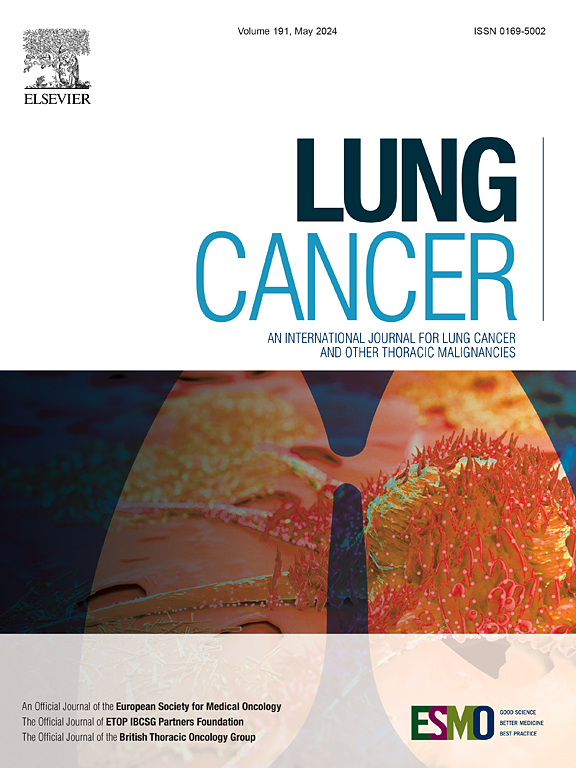Cost-effectiveness of next-generation sequencing for advanced EGFR/ALK-negative non-small cell lung cancer
IF 4.5
2区 医学
Q1 ONCOLOGY
引用次数: 0
Abstract
Objectives
This study aimed to evaluate the cost-effectiveness of next-generation sequencing (NGS) versus sequential single-gene testing (SGT), including the long-term costs and survival outcomes of relevant treatments for advanced EGFR/ALK-negative non-small cell lung cancer (NSCLC).
Materials and Methods
We developed a decision tree linked to a partitioned survival model to estimate the clinical outcomes and costs over the five-year analysis period. The decision tree consisted of treatment types based on molecular biomarker (ROS1, BRAF, NTRK, MET, RET, and KRAS alterations) test results. The probability of receiving each targeted therapy was estimated based on 1) the testing rate, 2) the proportion of alterations detected, and 3) the proportion of patients receiving treatment consistent with the testing results. We estimated the long-term overall survival and progression-free survival for each treatment using parametric estimation by reconstructing patient-level data from clinical trials. The costs of testing, drugs, administration, physician visits, monitoring, adverse events, post-progression, and end-of-life care were included. The utility values were obtained from a previous study. The incremental cost-effectiveness ratio (ICER) was used to evaluate the cost-effectiveness of NGS within a threshold of $38,701 (50,000,000 KRW) per quality-adjusted life year (QALY).
Results
The incremental life-years (LYs) and QALYs for the NGS group versus the SGT group were 0.028 and 0.023, respectively. The total medical cost for the NGS group was $8,375 higher than that for the SGT group. The difference in drug costs accounted for most of the differences in total medical costs. NGS was not cost-effective compared to sequential SGT, with an ICER of $300,233/LY and $359,405/QALY, respectively.
Conclusions
NGS is not cost-effective for advanced EGFR/ALK-negative NSCLC, but has a survival benefit over sequential SGT. Our findings provide a basis for decision-making regarding the coverage and clinical utilization of NGS in regions where EGFR alterations are prevalent.
晚期表皮生长因子受体/ALK阴性非小细胞肺癌的新一代测序成本效益。
研究目的本研究旨在评估新一代测序(NGS)与顺序单基因检测(SGT)的成本效益,包括晚期表皮生长因子受体(EGFR)/ALK 阴性非小细胞肺癌(NSCLC)相关治疗的长期成本和生存结果:我们开发了一个与分区生存模型相连的决策树,以估算五年分析期内的临床结果和成本。决策树包括基于分子生物标志物(ROS1、BRAF、NTRK、MET、RET 和 KRAS 改变)检测结果的治疗类型。接受每种靶向治疗的概率是根据:1)检测率;2)检测到的改变比例;3)接受与检测结果一致的治疗的患者比例估算的。我们通过重构临床试验中患者层面的数据,使用参数估计法估算了每种疗法的长期总生存期和无进展生存期。检测、药物、管理、就诊、监测、不良事件、进展后和临终关怀的成本也包括在内。效用值来自之前的一项研究。在每质量调整生命年(QALY)38,701 美元(50,000,000 韩元)的临界值范围内,采用增量成本效益比(ICER)评估 NGS 的成本效益:结果:NGS 组与 SGT 组的增量生命年 (LY) 和 QALY 分别为 0.028 和 0.023。NGS 组的总医疗费用比 SGT 组高 8375 美元。药物成本的差异是总医疗成本差异的主要原因。与序贯 SGT 相比,NGS 不具成本效益,ICER 分别为 300,233 美元/LY 和 359,405 美元/QALY:NGS治疗晚期表皮生长因子受体/ALK阴性NSCLC不具成本效益,但与序贯SGT相比具有生存获益。我们的研究结果为在表皮生长因子受体(EGFR)改变普遍的地区就 NGS 的覆盖范围和临床应用做出决策提供了依据。
本文章由计算机程序翻译,如有差异,请以英文原文为准。
求助全文
约1分钟内获得全文
求助全文
来源期刊

Lung Cancer
医学-呼吸系统
CiteScore
9.40
自引率
3.80%
发文量
407
审稿时长
25 days
期刊介绍:
Lung Cancer is an international publication covering the clinical, translational and basic science of malignancies of the lung and chest region.Original research articles, early reports, review articles, editorials and correspondence covering the prevention, epidemiology and etiology, basic biology, pathology, clinical assessment, surgery, chemotherapy, radiotherapy, combined treatment modalities, other treatment modalities and outcomes of lung cancer are welcome.
 求助内容:
求助内容: 应助结果提醒方式:
应助结果提醒方式:


